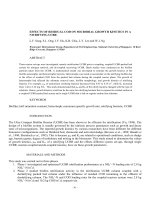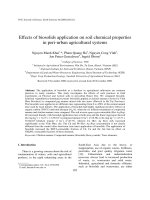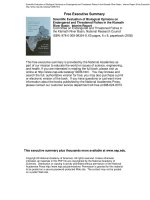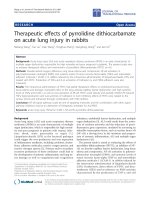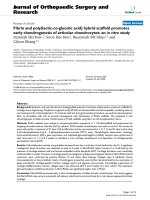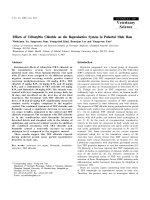Evaluation of antibacterial effects of bile salt on pathogenic bacteria - An in vitro study
Bạn đang xem bản rút gọn của tài liệu. Xem và tải ngay bản đầy đủ của tài liệu tại đây (140.11 KB, 7 trang )
Int.J.Curr.Microbiol.App.Sci (2019) 8(10): 2430-2436
International Journal of Current Microbiology and Applied Sciences
ISSN: 2319-7706 Volume 8 Number 10 (2019)
Journal homepage:
Original Research Article
/>
Evaluation of Antibacterial Effects of Bile Salt on
Pathogenic Bacteria- An in vitro Study
Anuradha Tyagi*, Vanita Gupta and Aseem Bhatnagar
Department of Capacity Enhancement & Product Implementation, Institute of Nuclear
Medicine and Allied sciences, Brig S. K. Mazumdar Road, Delhi- 110054, India
*Corresponding author
ABSTRACT
Keywords
Bile salt, E. coli, S.
aureus,
Antimicrobial
Article Info
Accepted:
17 September 2019
Available Online:
10 October 2019
Antibiotics are the first line of defence against bacterial infections. Overuse/misuse of
antibiotics has led to the emergence of antibiotics resistant bacterial strains, making
them ineffective. Alternative approaches should be sought to handle this challenge.
Bile salt is a cation compounded form of bile acid and is synthesized in the liver.
Reduction in the flow of bile salts has led to bacterial translocation in the body.
Therefore, the aim of the present study was to evaluate the in vitro effect of bile salt
on E. coli and S. aureus. This work also investigated the additive effect of bile salt in
combination with other antibiotics namely gentamycin and ciprofloxacin. Bile salt
exhibited maximum zone of inhibition (ZI) of 4.8±0.28mm against E. coli while
against S. aureus, 12.0±0mm ZI was observed. While exploring the additive effect of
bile salt, it enhanced the ZI of gentamycin and ciprofloxacin against both the
microorganisms. Bile salt was also found effective in damaging the cell membrane of
S. aureus which was evident by nucleic acid and protein leakage. This effect remained
absent with E. coli. Thus, bile salt showed significant antibacterial activity against
gram-positive microorganism while gram-negative remained resistant. Bile salt also
exhibited additive effect in combination with gentamycin and ciprofloxacin.
Introduction
Antibiotics are the medications that are used
to destroy or slow down the growth of
bacteria. The uncontrolled improper use of
antibiotics for treatment of bacterial infections
has led to the emergence of antibiotic resistant
strains and is becoming an issue of global
concern. Thus, there is an urgent need to
investigate new agents having antibacterial
properties to combat the issue of antibiotic
resistance. In the last decade, no new
antibiotic has come up due to slow drug
discovery. Since the development of new
antibiotic is complicated and difficult process,
so augmentation of present antibiotics might
be a one of the strategies (Khoshnood et al.,
2017).
There are various natural and synthetic
compounds which contain antimicrobial
properties; these non-antibiotic agents may
2430
Int.J.Curr.Microbiol.App.Sci (2019) 8(10): 2430-2436
have a direct antibacterial activity or augment
the effect of antibiotics losing its property.
Materials and Methods
Chemicals
Therefore, these agents might be a strategy to
modify the bacterial metabolism and act
additively or synergistically with already
existing antibiotics (Martins et al., 2008).
Bile salts are synthesized in the liver from
cholesterol, conjugated with glycine or taurine
and secreted in bile with cholesterol and
lecithin (Cowen et al., 1977). It is a biological
detergent and plays an important role in
maintaining intestinal microbiome. Alterations
in the level of bile salts can lead to increased
colonization by pathogens.
In previous studies, bile salt showed
antibacterial activity against biliary pathogenEnterococcus fecalis (Sung et al., 1993). Bile
salts inhibited bioenergetic process by
intracellular acidification and dissipation of
the proton motive force (Kurdi et al., 2006).
They are known to cause induction of DNA
damage and protein denaturation (Merritt and
Donaldson, 2009). Bile salts were reported to
help in reducing endotoxemia in obstructive
jaundice patients (Cahill et al., 1987).
In animal models, cholestasis leads to
structural changes in the enterocytes which is
associated with bacterial translocation
(Lorenzo-Zuniga et al., 2003) which may
further lead to sepsis (Wiest et al., 2014). It
was reported that oral supplementation of bile
salts in cirrohitic rats can prevent small
intestinal
bacterial
overgrowth
and
translocation (Lorenzo-Zuniga et al., 2003).
Therefore, the aim of the current study was to
evaluate the in vitro effect of bile salt alone
and in combination with existing antibiotics
(gentamycin and ciprofloxacin) against the
selected test microorganism (E. coli and S.
aureus).
Bile salt was obtained from Sigma-Aldrich (St
Louis, MO, USA). Ciprofloxacin and
gentamycin were purchased from Titan
chemicals, India. Muller Hinton (MH) broth,
Nutrient broth and Agar were purchased from
Himedia, Mumbai, India. Bacterial cultures
Escherichia
coli
(MCC2412)
and
Staphylococcus aureus (NCC2043) were
obtained and maintained as stock culture in
the laboratory.
Antimicrobial sensitivity test
Antimicrobial susceptibility of all bacterial
strains was determined following the disc agar
diffusion method. The bacterial strains were
cultured overnight, diluted in MH broth to a
McFarland turbidity of 0.5 [108 colony
forming unit (CFU)/ml] and then seeded on
MH agar plates. Sterile discs (6mm)
containing different concentrations of bile salt
were placed on the inoculated agar plates.
After incubation for 24 hours at 37˚C, the
zone of inhibition (ZI) was measured. Further,
to evaluate the additive effect of bile salt, two
standard antibiotics namely gentamycin
(10µg/disc) and ciprofloxacin (5µg/disc) were
used in combination with bile salt against E.
coli and S. aureus. The antibiotic discs were
further
impregnated
with
different
concentrations of bile salt and placed on agar
plates containing bacterial culture. The ZI was
measured and interpreted after completion of
incubation period.
Measurement of nucleic acid and protein
leakage
Bacterial cells were cultured and treated with
different concentrations of bile salt, and
samples were collected over a time course of
30, 60, 90, 120, and 150 minutes. The
2431
Int.J.Curr.Microbiol.App.Sci (2019) 8(10): 2430-2436
suspension was centrifuged at 8000 x g for 10
minutes and then the supernatant was filtered
using a 0.22µm pore size membrane filter.
Leakage of nucleic acids and proteins upon
treatment with the bile salt were monitored by
measuring 260 and 280 nm absorbance in the
culture medium respectively in a Biogentek
Microplate reader.
Results and Discussion
The current study illustrated the effect of bile
salt on two microorganisms- E. coli and S.
aureus. Antimicrobial sensitivity of bile salt
showed that bile salt possesses antimicrobial
activity against the S. aureus in disc diffusion
method. The study revealed that bile salt
exerted its antimicrobial effect in a dose
dependent manner against S. aureus with a
maximum ZI of 13.6±0mm. However, bile salt
remains non-effective against E. coli. Bile salt
exhibited ZI ranging from 3.2mm to 5mm
against E. coli (Table 1) while in case of S.
aureus the ZI ranges from 5.1mm to 13.6mm
(Table 2). Thus, the results indicated that bile
salt showed antimicrobial properties against
gram positive bacteria only. To evaluate the
additive effect of bile salt, it was used in
combination
with
antibiotics
namely
gentamycin (10µg) and ciprofloxacin (5µg).
Using disc diffusion method, it was observed
that bile salt increased the ZI of gentamycin
and ciprofloxacin, against E. coli (Table 1).
Similar effect was observed when bile salt and
antibiotics combination was used against S.
aureus (Table 2).
Nucleic acid and protein leakage was studied
to evaluate the effect of bile salt on cell
membrane. Nucleic acid content is directly
proportional to the O.D value at 260nm. Thus,
leakage of nucleic acid was measured at
260nm and found to increased in comparison
to negative control (0.9% saline) (Fig. 1) in
case of both microorganisms. However, in
case of E. coli, the increase in leaked nucleic
acid was not significant. Similarly, leakage of
cellular protein (280nm) was only observed in
S. aureus treated with bile salt. A significant
(p<0.01) increase in protein content was
observed upon exposure to bile salt (Fig. 2).
The UV absorbance value increased with time
of exposure to bile salt. Bile salt remained
ineffective to bind and disturb the cell
membrane integrity of E. coli and thus, nonsignificant protein content was found.
Bile salts are synthesized in the liver from
cholesterol. They are cation compounded form
of bile acid and are amphipathic in nature. The
data of the current study indicates that bile salt
has inhibitory action on the growth of S.
aureus and E. coli remain ineffective to the
action of bile salts. The cell wall composition
of gram negative bacterium E. coli became a
barrier for bile salt to invade and show its
action against E. coli. Previous studies also
reported
the
efflux
of
bile
salt
chenodeoxycholate by E. coli (Thanassi et al.,
1997). Both E. coli and S. aureus are
commensal bacterium and human pathogens.
E. coli is most frequently responsible for
urinary tract infections whereas S. aureus is
leading cause of bacteremia and infective
endocarditis. The effect of bile salt on the
growth of microorganisms was also reported
in prior studies. Sung et al., 1993 showed that
hydrophobic bile salts played a role of growth
inhibitor against E. coli and E. fecalis.
Sannasidappa et al., 2017 found that
unconjugated bile salts possess more potent
antibacterial properties against S. aureus in
comparison to conjugated bile salts.
Our study showed that the use of bile salt
accelerated the action of some of the
antibiotics (gentamycin and ciprofloxacin).
Previously, bile salt was reported to increase
the solubility of rifaximin and thus enhanced
its antibacterial effect (Darkoh et al., 2010).
Oxgall bile salts enhanced cell envelope
permeability circumvented the lack of
2432
Int.J.Curr.Microbiol.App.Sci (2019) 8(10): 2430-2436
cytochrome-driven antibiotic uptake, thereby
changing
aminoglycoside
susceptibility
(Elkins and Mullis, 2004). Oxgall bile salt also
changed intrinsic resistance of most
lactobacilli (and some bifidobacteria) to
polymyxin B, by cell membrane disruption
(Charteris et al., 2000).
Table.1 Antimicrobial activity of bile salt alone and in combination with gentamycin and
ciprofloxacin using disc diffusion method against E. coli
BS (mM)
0
1
2
5
10
15
20
Zone of Inhibition (mm)
ZI by bile
Gentamycin
salt alone
(10µg) + BS
0
9.0±0.2
3.2±0.14
9.0±0.1
4.9±0.14
9.0±0.25
4.8±0.14
8.5±0.36
4.9±0.28
10±0.05
5±0.07
12±0.05
4.8±0.28
12.1±0
Ciprofloxacin
(5µg) + BS
10+0.05
10±0.1
10±0.11
11±0.14
12.5±0.25
13.2±0.2
13.1±0.22
Data are mean of 3 independent experiments
BS- Bile salt
ZI- Zone of inhibition
Table.2 Antimicrobial activity of bile salt alone and in combination with gentamycin and
ciprofloxacin using disc diffusion method against S. Aureus
BS (mM)
0
1
2
5
10
15
20
Zone of Inhibition (mm)
ZI by bile
Gentamycin
salt alone
(10µg) + BS
0
12.0±0.0
5.1±0.14
12.0±1.2
5.4±0.28
12.1±0.5
7.0±0.14
12.23±0.29
10.1±0.14
13.0±0.25
13.5±0.41
14.5±0.05
13.6±0.0
15.8±0.25
Data are mean of 3 independent experiments
BS- Bile salt
ZI- Zone of inhibition
2433
Ciprofloxacin
(5µg) + BS
13.0±0.12
13.0±0.22
13.0+0.5
13.2±0.01
14.1±0.26
16.0±0.26
16.0±0.22
Int.J.Curr.Microbiol.App.Sci (2019) 8(10): 2430-2436
Fig.1 Measurement of cellular leakage of nucleic acid from (A) E. coli and (B) S. aureus upon
exposure to bile salt. Cell density of 108 CFU/ml was treated with 20mM of bile salt. UCUntreated control. Data is presented as mean ± S.E of 3 independent experiments. *p<0.01
significant in comparison to UC
Fig.2 Measurement of leakage of cellular protein from (A) E. coli and (B) S. aureus upon
exposure to bile salt. Cell density of 108 CFU/ml was treated with 20mM of bile salt.
UC- Untreated control. Data is presented as mean ± S.E of 3 independent experiments. *p<0.01
significant in comparison to UC
Bile salt plays an important role in the internal
defense mechanisms of the body. It helps in
maintaining indigenous microbiota and
protects against enteric pathogens in the
intestine (Sung et al., 1993; Itoh et al., 1999).
Reduced levels of bile salts in the intestine
correlate with cases of bacterial overgrowth
and translocation in the small intestine,
leading to endotoxemia in cirrhotic rats
(Lorenzo-Zuniga et al., 2003). Being
amphiphatic, bile salt contains hydrophilic as
well as hydrophobic structural components.
Due to their detergent nature, bile salt exerts
its effect on cell membrane by lysing them or
by inducing cell death pathway (Perez and
Briz, 2009). In our study also, the leakage of
nucleic acid and protein (Fig. 1 and 2) could
be attributed due to cell membrane lysis. Bile
salt can rapidly dissolve integral membrane
lipids and cause dissociation of integral
membrane proteins (Coleman et al., 1980).
Due to these features, bile salts has been used
for treatment of various clinical conditions
such as in case of severe steatorrhea (Fordtran
et al., 1982), psoriasis (Gyuresovics and
Bertok, 2003), and prevention of postoperative
2434
Int.J.Curr.Microbiol.App.Sci (2019) 8(10): 2430-2436
renal failure in patients with obstructive
jaundice (Cahil, 1983).
Bile salt has significant antimicrobial activity
against gram positive bacteria with a potential.
additive effect when used in combination
with either gentamycin or ciprofloxacin.
Herein, further studies are warranted to
elucidate the main mechanism of additive
action of bile salt in combination with specific
antibiotics.
References
Cahill, C.J. 1983. Prevention of postoperative
renal failure in patients with
obstructive jaundice- the role of bile
salts. BJS, 70(10): 590-95.
Cahill, C.J., Pain, J.A., Bailey, M.E. 1987.
Bile salts, endotoxin and renal function
in obstructive jaundice. Surg Gynecol
Obstet. 165(6):519-22.
Charteris, W.P., Kelly, P.M., Morelli, L.,
Collins J.K. 2000. Effect of
Conjugated Bile Salts on Antibiotic
Susceptibility of Bile Salt–Tolerant
Lactobacillus and Bifidobacterium
isolates. Journal of Food Protection,
63(10): 1369–1376.
Coleman, R., Lowe, P.J., Billington. D. 1980.
Membrane lipid composition and
susceptibility to bile salt damage.
Biochim. Biophys. Acta, 599(1): 294300.
Cowen, A.E., Campbell, C.B. 1977. Bile salt
metabolism. I. The physiology of bile
salts. Aust N Z J Med. 7(6): 579-86.
Darkoh, C., Lichtenberger, L.M., Ajami, N.,
Dial, E.J., JIANG, Z., Dupont, H.L.
2010. Bile Acids Improve the
Antimicrobial Effect of Rifaximin.
Antimicrobial
Agents
and
Chemotherapy, 54(9): 3618–3624.
Elkins, C.A., Mullis, L. B. 2004. Bilemediated aminoglycoside sensitivity in
Lactobacillus species likely results
from increased membrane permeability
attributable to cholic acid. Appl.
Environ. Microbiol. 70(12): 72007209.
Fordtran, J.S., Bunch, F., Davis, G.R. 1982.
Ox Bile Treatment of Severe
Steatorrhea in an Ileectomy-Ileostomy
Patient. Gastroenterology, 82(3):564-8.
Gyurcsovics,
K.,
Bertók,
L.
2003.
Pathophysiology of psoriasis: coping
endotoxins with bile acid therapy.
Pathophysiology, 10(1): 57-61.
Itoh, M., Wada, K., Tan, S., Kitano, Y., Kai.
J., Makino, I. 1999. Antibacterial
action
of
bile
acids
against
helicobacter pylori and changes in its
ultrastrural morphology: effect of
unconjugated dihydroxy bile acid. J.
Gastroenterol., 34(5): 571-576.
Khoshnood, S., Heidary, M., Mirnejad, R.,
Bahramian, A., Sedighi, M., Mirzaei,
H. 2017. Drug-resistant gram-negative
uropathogens: A review. Biomed
Pharmacother, 94, 982-94.
Kurdi, P., Kawanishi, K., Mizutan, K.,
Yokota, A. 2006. Mechanism of
growth inhibition by free bile acids in
Lactobacilli
and
Bifidobacteria.
Journal of Bacteriology, 188 (5):19791986.
Lorenzo-zuniga, V., Bartoli, R., Planas, R.,
Hofmann, A.F., Vinado, B., Hagey, L.
R., Hernández.
J.M., Mañé,
J., Alvarez. M.A., Ausina, V., Gassull.
M.A. 2003. Oral bile acids reduce
bacterial
overgrowth,
bacterial
translocation, and endotoxemia in
cirrhotic rats. Hepatology 37(3): 551–
557.
Merritt M.E., Donaldson. J.R. 2009. Effect of
bile salts on the DNA and membrane
integrity of enteric bacteria. J. Med.
Microbiol. 58(12): 1533–1541.
Perez, M.J., Briz. O. 2009. Bile acid induced
cell injury and protection. World
Journal of Gastroenterology. 15(14):
2435
Int.J.Curr.Microbiol.App.Sci (2019) 8(10): 2430-2436
1677-1689.
Prieto, A.I., Ramos-morales, F., Casadesus. J.
2004. Bile-induced DNA damage in
Salmonella enterica. Genetics, 168(4):
1787–1794.
Sannasiddappa, T.H., Lund, P.A., Clarke S.R.
2017. In vitro antibacterial activity of
unconjugated and conjugated bile salts
on Staphylococcus aureus. Frontiers in
Microbiology, 8, 1581.
Sung, J.Y., Shaffer, E.A., Costerton, J.W.
1993. Antibacterial activity of bile
salts
against
common
biliary
pathogens. Effects of hydrophobicity
of the molecule and in the presence of
phospholipids. Dig Dis Sci., 38(11) :
2104-12.
Thanassi D G, Cheng L W, Nikaido H. 1997.
Active efflux of bile salts by
Escherichia coli. J bacteriol., 179(8):
2512-2518.
Wiest, R., Lawson, M., Geuking, M. 2014.
Pathological bacterial translocation in
liver cirrhosis. J Hepatol., 60(1):197–
209.
How to cite this article:
Anuradha Tyagi, Vanita Gupta and Aseem Bhatnagar. 2019. Evaluation of Antibacterial
Effects of Bile Salt on Pathogenic Bacteria- An in vitro Study. Int.J.Curr.Microbiol.App.Sci.
8(10): 2430-2436. doi: />
2436
